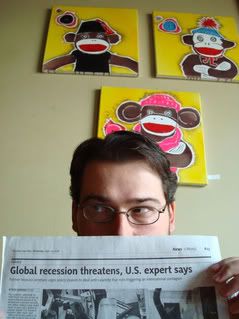An Exclusive Interview with Primatologist Frances White

Frances White (second from right), Bila-Isia Inogwabini (third from left) and team in DR Congo.
Dr. Frances White is an Assistant Professor of Anthropology at the University of Oregon. She was featured in the PBS Special: The Last Great Ape. This interview was featured in my Wildlife Conservation article Behind Enemy Lines. Part 1 of this interview can be viewed here.
You last visited the Lomako field station in 1998. Historically, what have conditions been like for bonobos?
It’s really fluctuated over time in terms of the impact on the animals so, when I first went in the early 80s, it was at low point for the economy. So in the 70s what had happened was that the economy was actually improving, and that was bad for the pygmy chimps. This is because it was increasing the amount of money and resources and guns and shotgun shells that were making their way into the hands of either ordinary people or soldiers who were going along the river shooting elephants or animals for bush meat or animals for trade.
In the 80s there was only one shotgun in the area and the person who had it couldn’t get shells so there was very little hunting. There was some snare trapping, but there was very little. But there was also the fact that the researchers were there fairly continually, and having primatologists present does an enormous lot to protect the animals. So people wanted to keep us there and they knew we wouldn’t stay if the animals were disappearing. So physically being there through the 80s and through the 90s was really good.
I understand that there were approximately 10,000 bonobos alive in the wild prior to the civil war, is that the correct figure?
I don’t know. I think they’re often very much guesstimates, depending who sat down and tried to work it out based on aerial pictures of habitat or estimates from different areas. I would say that sounds reasonable to me.
However, they are extremely endangered. So how would that compare to other endangered species? In other words, how endangered are they?
I would say they’re highly endangered because they’re so big, which makes them long lived and very, very, very slow to reproduce. So any impact to the population is going to be enormous and extremely slow to recover. So if a female doesn’t have babies until she’s thirteen years old, or a male doesn’t reproduce until he’s twenty, that’s a population that’s extremely susceptible to being completely wiped out.
Even ignoring the whole bush meat trade questions, any habitat disturbance is going to take them out first because they’re specialist frugivores and they’re always the first ones to go when habitats are disturbed. And, of course, when you take out the specialist frugivore, the forest is never going to regenerate, so you essentially lose the rain forest too. After the trees there have died they won’t be replaced because bonobos are the main fruit dispersers.
So what, in your view, should be done to protect bonobos?
Well, the big problem compared to all other apes is that they only occur in the Democratic Republic of the Congo. So they’re restricted to one country and that means that this one country’s policy of preserving them is the only thing determining whether or not they survive. So unlike other species that go across country borders, bonbos, or pygmy chimps, are found only in the Congo. So it has to be a one country solution to the problem. And that’s, of course, a country where protecting a wild ape is relatively low on its priority list, given all the civil war problems and all the economic problems in the country.
So I think that an international effort has to be involved to get them protected, especially ways that natural areas can be preserved. The Lomako area, where I work, is not a national forest, it is not protected in any way, and we’ve tried many times, and at times have gotten fairly far along with trying to get the area protected, but it isn’t protected in any way. So those sorts of things can happen with international support, and things like debts and nature swaps and other sorts of international cooperative agreements that can make it to the country’s benefit to help preserve the species.
I know Rwanda has made great strides in protecting gorillas because it found an economic benefit involved. Congo hasn’t seen that benefit so far?
No, and they won’t. It’s a very different situation. Ecotourism is not going to work for pygmy chimps in the same way that it works for gorillas and can work in some areas for common chimps, because of the way their habitat is so isolated in the interior of the country. It’s very hard to get to and very hard to protect tourists when they’re there. When I was in the field we had a National Geographic crew that was going to come in and they couldn’t get all the way to the site so they gave up. We’ve had soldiers try to come in at various times to check papers or check what was going on, and they would also give up and go back and not get into the site. So the isolation which can also be a benefit can also prevent solutions such as ecotourism. So it’s a very different situation from gorillas.
When do you hope to return to the Lomako Forest?
We’re hoping not next year but the year after, but its funding contingent as always. So we’re hoping to have a team come back soon, if we can get the funding.
[Editor's Note: Frances White recently received a grant and is presently in the Democratic Republic of Congo continuing her research.]


















4 comments:
Why didn't Ian Parker even mention Dr. Frances White in his New Yorker piece?
I'm not sure. It might be simply that he got access through Hohmann's team and left it at that. I thought it was unfortunate that Ian Parker's article was so clearly biased against Frans de Waal. As you'll read in Dr. White's first interview, she doesn't view bonobos the way de Waal does but neither does she agree with Hohmann. Parker created a dichotomy in his piece. It's a standard journalist tactic. You argue against one extreme and, if you demonstrate that extreme has any faults, you confidently assert the opposite must be true. Look at how he sets the piece up. He doesn't go to a primatology conference where people seriously discuss the evidence. He goes to a funding meeting where the people who are trying to save a species from extinction appeal to the audience's preferences. The same appeal would be made along an economic framework if the audience was filled with conservatives. It was a poor way to frame the issue.
However, I think the controversy can only help the bonobos because it will agitate those who identify with the vision and it will bring them to the attention of others who have never heard of the species. If we don't start giving money (seriously, that's what makes the difference) bonobos aren't going to survive for our grandchildren to debate about.
Another possibility, of course, is the question of who gets to define female sexuality. Isn't it interesting that in a species that challenges the standard patriarchal norm only male primatologists were asked for their opinion? I don't think this is a peripheral issue.
I wondered as well why Dr. White wasn't even mentioned. However cynical it may sound I'm not convinced giving money makes a difference however. Send money to who, and in whose hands will it end up? There seems to be no shortage of well-staffed conservation organizations asking for (and receiving) donations, yet the situation still continues to be grim for apes such as bonobos and orangutans who have the misfortune of living in politically conflicted, desperately poor countries. There would have to be an end to corruption and a shift in politics - and perhaps even cultural traditions - for there to be real change. Or of course the human population may one day stop growing exponentially. That would help.
Post a Comment